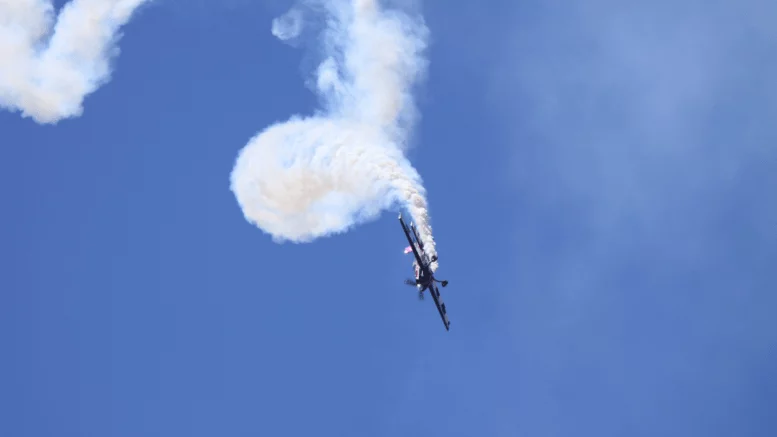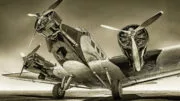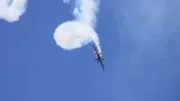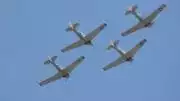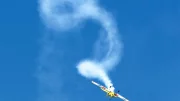4 Amazing High Flying Airplane Maneuvers
Sometimes the dazzling performances at air shows move so quickly that it’s difficult to fully appreciate the technical ability and practice which go into making them part of the day. Understanding more about the various airplane maneuvers one might see at an airshow increases appreciation for how difficult they are, as well as the aerodynamic principles behind them.
The major airplane maneuvers you might see at air shows developed over time, some from the earliest days of aviation. Others, like those discussed here, are more recent. Sometimes they are combined or presented as part of a series of tricks. Here’s a closer look at them.
The Tailslide
Tailslides make the most of gravity and basic aerodynamic principles. The pilot begins the maneuver in straight and level flight, then performs a quarter loop which ends in ninety degree vertical climb. At the moment the climb ends, the pilot uses the thrust vectoring technology on a jet engine to stay in one place as long as he or she can. When gravity eventually takes over, the airplane begins to drop back towards the ground, tail first. The pilot then drops the nose to vertical into a dramatic dive. A similar maneuver, called the “bell,” incorporates a roll while returning to horizontal flight. Tales of tailsliding in aerobatic flying go back as far as 1913, courtesy of aviation pioneer Louis Beleriot.
A pilot depends on a temporary reverse of airflow over the surfaces of the airplane in order to make a tailslide work. Since this usually takes place at a somewhat high rate of speed with a sudden reversal, it’s important to perform this maneuver only in aircraft with an airframe and connection points which are strong enough to withstand these forces. That’s why you might see some aerobatic airplanes performing loops and barrel rolls, but not a tailslide. While most of the maneuvers discussed here may be exclusively performed by jets, a tailside can also take place with experienced pilots in propeller-driven airplanes.
Pugachev’s Cobra
Although only introduced to the aviation community in 1989, Pugachev’s Cobra is now considered the foundation for many modern airplane maneuvers. Pugachev’s Cobra is also simply known as “the Cobra.” In Sweden, it’s called a “Short Parade” and a “Zero Speed Maneuver” by the Syrian aviation community. No matter the name, Pugachev’s Cobra requires a great deal of skill and accuracy on the part of the pilot.
Pugachev’s Cobra places the airplane in a position just past vertical. The airplane takes this attitude while flying at a high rate of speed, then it returns to a horizontal position. The effect creates a purposeful stall, but the airplane’s altitude remains the same. Precise pitch control, as well as stability, are musts. These airplane maneuvers are not possible on just any airplane; it acts as an airbrake on the jet engine, and the pilot must have a full understanding of the aerodynamics at work.
The Pugachev in Pugachev’s Cobra is the legendary Viktor Georgiyevich Pugachev, who flew as a test pilot in the USSR Air Force. In addition to breaking many speed records, he was the first to demonstrate the maneuver in public in an Su-27. Other airplanes capable of performing Pugachev’s Cobra include:
- The Su-57
- X-02S Strike Wyverm
- F-22A Raptor
- The ADF-01 FALKEN
This maneuver takes place at subsonic speeds and marked the beginning of a new era in aerial combat, as well as air show performance technology. It’s generally agreed that while Pugachev’s Cobra in itself is not very useful in a dogfight, it forms the bases of other moves which are.
The Herbst Maneuver
In the Herbst Maneuver, which can be used to great effect in aerial combat, a pilot requires a jet engine with post-stall technology and a tremendous amount of practice. Post-stall technology is a major part of supermaneuvrability, which refers to a “controlled loss of control” beyond what is typically possible in aeronautics with usual capabilities. The Herbst Maneuver is also known as “the J-turn.” It is usually considered a variation of the Pugachev’s Cobra.
When a pilot performs the Herbst maneuver, he or she relies on thrust vectoring. Thrust vectoring, or thrust vector control, is the technology which advanced fighter aircraft have to change the direction of their exhaust nozzles relative to the rest of the airplane, as opposed to older jet aircraft, which have fixed exhaust nozzles. This enables much more maneuverability.
The Herbst maneuver demands a high angle of attack, which takes place when the relative wind strikes an airfoil at a high angle. This is made possible by the sweep of the wing; it’s not necessary for training aircraft or typical passenger jets, but it is extremely useful in aerial dogfighting. The Herbst maneuver developed from this advanced technology and training.
In it, the pilot rapidly reverses course while returning to its original direction. The reversal takes place while the airplane is rolling. It’s named after Dr. Wolfgang Herbst, who worked for Messerschmitt-Bolkow-Blohm, a German engineering and aircraft manufacturing company (known in the World War II era as Messerschmitt.) Dr. Herbst helped to initiate the Rockwell SNAKE, which was used as the base for the X-31 aircraft. His research and engineering breakthroughs helped to form the bedrock of post-stall technology. A Herbst Maneuver was first successfully executed in 1993 by an X-31.
The Kulbit
Many airplanes which can perform Pugachev’s Cobra are also capable of the Kulbit. “Kulbit” is a rough translation of “somersault” in Russian, and, as the name indicates, it involves a Pugachev’s Cobra which is exited via a backflip. The Kulbit, then, is an extremely tight aeronautical loop, an innovation also only possible with thrust vectoring.
Airplane loops which were first performed with biplanes required an enormous radius, one large enough to produce enough lift over the wings of the craft. Yevgeni Frolov, who, like Pugachev, was a test pilot in the USSR, was the first to verifiably perform this feat in a Sukhoi. For that reason, “the Kulbit” is also known as “Frolov’s Chakra” in certain aviation communities.
Ready to Soar with Us?

